What to do if the rings of the drain pit sag: methods for eliminating the problem
Sewage points made of concrete rings have become popular due to their availability and low cost.If the structure is assembled and arranged correctly, it will last for decades without repair. However, sometimes the concrete elements are displaced, and the cesspool ceases to fulfill its function - collecting sewer flows.
We will tell you what to do if the drain pit rings have sagged, and how to prevent further movement of the parts. The article we presented describes ways to stop subsidence and effective actions to restore the shape of the drainage pit. Recommendations for the prevention of such processes are given.
The content of the article:
Designs of drainage pits made of concrete rings
To understand the reasons for the displacement and determine the method of repair, it is necessary to have a good understanding of the structural features of sewer structures. Most of them are buried in the ground, therefore, you need to be able to understand the characteristics of the soil. First, let's remember the technology for installing storage tanks made of concrete rings.
How to build a sewer storage tank?
There are many options for constructing a drainage pit, without which the local sewer system would be incomplete.
A volumetric tank, buried in the ground at some distance from the house, serves to collect wastewater.Cement pouring, ready-made concrete rings, brickwork and even rubber car tires are used as building materials for assembling the structure.
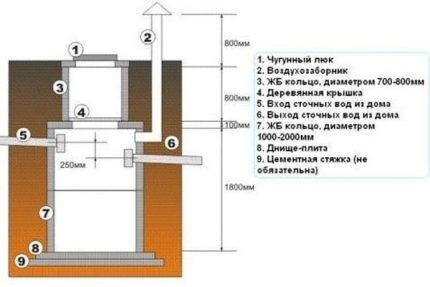
Let's stop at the storage well from reinforced concrete or concrete rings. Large parts (with a diameter of 1 m or more) have quite a lot of weight, so transportation and installation of components is carried out with the help of special equipment and workers.
But strong and fairly wear-resistant cylindrical elements have a low cost, so half of all cesspools in summer cottages and small cottages are built from them. To build an underground structure, you will need 2-3 factory-made rings.
Making similar parts yourself is difficult and irrational, while all the components of a storage tank are available for sale:
- standard diameter rings;
- closed element for bottom arrangement;
- round slabs;
- necks of smaller diameter (additional);
- plates with a hole for a hatch.
Rings for assembling a sewer well in a summer cottage can be made with your own hands. Step-by-step guide to making them given here, we recommend that you familiarize yourself with very useful information.
After preliminary calculations, the required kit is purchased, from which the sewer well is assembled. Before installing concrete parts, it is necessary to dig a pit, the width and depth of which is slightly larger than the size of the cesspool.

The first element, the bottom of the structure, is placed on a flat base, then 1 to 4 rings are placed on top of each other, carefully sealing the joints. To protect the concrete, mastic or other waterproofing is applied on both sides (external and internal).
After backfilling, only part of the neck and the technical hatch remain visible on the surface. It is needed for regular maintenance - pumping out accumulated waste.
With traditional diagrams and rules for calculating the depth of the drain pit read the article, analyzing all possible construction options.
Features of a sump device without a bottom
A drainage pit without a bottom is no longer a storage tank, but a structure with partial filtration of wastewater. The lower part of the cesspool is not clogged, but is equipped with a kind of filter - a thick layer of sand and crushed stone.The loose “cushion” allows the liquid medium to pass through itself directly into the soil, trapping solid and large particles.
If you want to build a simple treatment facility, you need at least two tanks: the first is the same storage tank, and the second is filter well.
In the first, solid waste settles and is partially processed, and the settled liquid flows into the next tank. It undergoes further anaerobic purification and penetration of liquid into the soil.
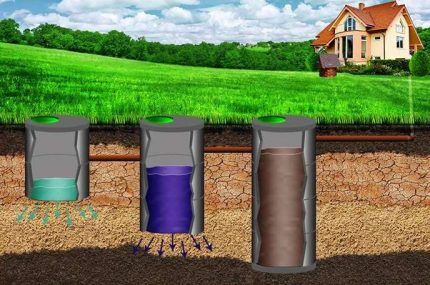
If the only container is made into a filter, the cleaning will be ineffective, and the wastewater will remain just as dangerous to the environment. In addition, the filter - a sand-pebble mixture - will have to be changed over time, since it will become dirty and clogged with waste quite quickly.
If you want to make a hole without a bottomIn order to call vacuum cleaners less often, one tank is not a solution. The construction of a cesspool with a soil filter occurs in the same sequence as a conventional storage tank, with one exception.
Instead of creating a sealed bottom, it is necessary to pour a thick layer of sand and then gravel. Do not forget about two important requirements: the surrounding soil must be sandy, or at least sandy loam, and the groundwater must be 1 m or more below the soil filter covering the bottom.
Reasons for subsidence of concrete rings
If, some time after the start of operation, you notice that the neck of the tank has settled or moved slightly to the side, it means that the structure has subsided or shifted.
You should also be wary if, with normal volumes of water consumption, the rate of accumulation of waste water has sharply decreased: it seems like it’s time to call the vacuum cleaners, but the reservoir is not even half full. Most likely, the joints between the rings have come apart, resulting in drainage occurring directly into the ground.
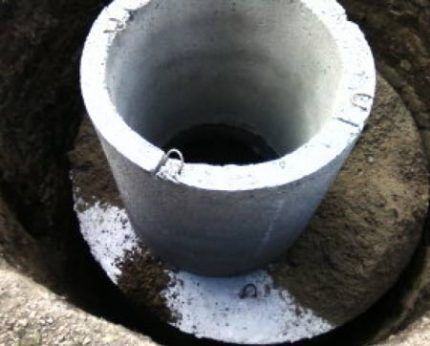
There can be several reasons for subsidence, displacement and destruction of a structure.
Factors worth considering include:
- groundwater level and mobility;
- mobility of the soil layers surrounding the tank;
- absence of a concreted (or otherwise fixed) bottom;
- violation of installation technology (uneven base, insufficient sealing of joints, lack of staples, etc.).
The water level is determined at the design stage. To do this, it is necessary to measure the distance from the soil surface to the aquifers. The best time to check is a rainy autumn or the period of spring snowmelt, when there is a maximum amount of water in the ground.
To determine, you just need to look into your own well and measure the water level in it. After all, most mine water intake structures at dachas are buried in the perched water, or, in extreme cases, in the first aquifer from the surface.
If an official drilling company drilled and equipped a well on your property or on a neighboring property, then it should have provided the customer with a report with documentation of the work performed. The papers issued by her must contain a geological section with hydrogeological marks of the groundwater level.
It happens that high groundwater does not manifest itself immediately, but after some time. Under their influence, layers of porous and subsidence soils are also deformed, which can also disrupt the stable position of the sewer tank.
Sandy soil is especially permeable to water. A layer of loose sand or loess sandy loam that has settled under a heavy tank can cause subsidence or rupture of the joint of concrete rings.
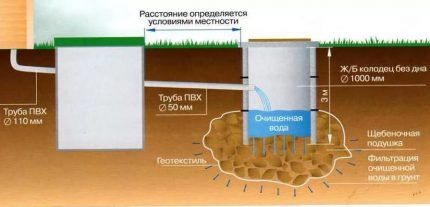
During subsidence, the entire structure descends, while during a rupture, the upper part remains in the same place, sandwiched by gravel-sand filling or sand-cement mixture, and the lower part comes off and “goes” down. Often, ground movements are a consequence of construction work taking place nearby.
Errors in sealing joints or arranging the bottom are common reasons for repairing cesspools. Especially if the bottom is not equipped with a concrete slab or at least a properly made filter. To determine the exact cause of subsidence or shifting of the rings, and then choose a repair method, it is necessary to completely empty the pit.
The methods for repairing a storage tank, a filter structure without a bottom, and even a water well, which are made from factory-made concrete rings, are similar.
Methods to stop the subsidence process
Repair work should always begin after the tank has been completely cleaned. To do this, they call the vacuum cleaners and, using special equipment, remove all the contents from the pit. Solid sediment stuck to the bottom must also be cleaned out with shovels or scrapers and lifted up with a bucket on a rope. Let us consider in more detail the methods of restoring a cesspool.
Dismantling the structure and installing the bottom
If subsidence is not a temporary phenomenon, but a permanent one, the structure must be dismantled as quickly as possible and the problem of the bottom structure must be solved. Most likely, before the construction of the sewerage point, no work was carried out to tamp and compact the base on which it was planned to install the column of concrete rings.
Action plan:
- Excavating the storage tank from all sides.
- Undoing the seams and lifting the rings up.
- Assessment of the condition of the pit bottom.
- Installation of a concrete slab.
- Reassembling the drive.
If after digging or at the next stage the hole quickly fills with water, repair work will not be possible.
There is a way out - you need to move the cesspool to another place and carry out the full cycle of required measures to sewer well installation, including compacting the bottom or strengthening it with cement mortar. The unstable position of the soil layers will sooner or later again cause the destruction of the prefabricated structure.
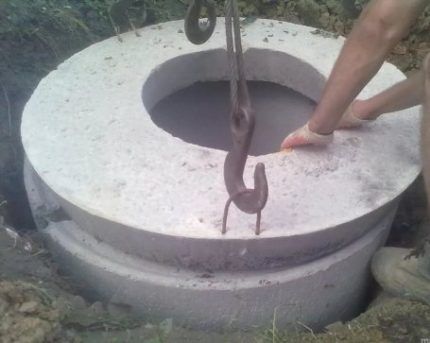
After thorough cleaning and excavation, the cause of the subsidence will be visible. Most often, it consists of a violation of the bottom construction technology. Therefore, it is necessary to strengthen and level the base and secure the bottom.
A layer of sand is poured onto a flat base, compacted, then a layer of crushed stone or gravel. The thickness of each layer is 0.35-0.45 m. They are leveled again and only then a concrete slab is laid.
The second option is reinforcement followed by concrete pouring. The bottom of the pit is reinforced with a mesh of metal reinforcement. The diameter of the rods is at least 10 mm, the cell sizes are no more than 0.2 m. The mesh is filled with cement mortar with a plasticizer added for strength. The drying time of the screed depends on the weather, but you will have to wait at least one week.
When it becomes clear that the bottom is firmly fixed, you can build the tank again, simultaneously sealing the joints and waterproofing the rings.
Securing the lower concrete ring
In more rare cases, the base under the well is done correctly, but the bottom ring still moves to the side.It is necessary to secure it - fix it on a concrete wall and fill it with cement mortar on the sides. If subsidence occurs downwards, the lower link should be stopped using additional devices.
One of the simplest options is to insert steel pipes into the walls of the ring, which are firmly fixed in the ground and will serve as insurance against further subsidence, even if the base moves a little.
To do this, holes are made in the walls of the lower link (from 4 to 6 pieces) and pipes with a diameter of at least 0.05 m are inserted into them. The cavity of each pipe must be filled with a solution to prevent water penetration.

If the soil is not dense enough and it is not possible to drive in the supporting parts, they will later be fixed when backfilled with a sand-gravel mixture, to which dry cement can be added for reliability.
Sealing the space between the rings
If two concrete links have come apart and there is a large space between them, there are several ways to solve the problem. First you need to find out whether the subsidence process has stopped. If not, then you will have to dismantle the structure, strengthen the bottom and rebuild the structure.
When stopping the subsidence process, you can go in two ways:
- Disassemble the structure to the point of repair, install the rings, secure them with brackets and seal the cracks.
- Make repairs without disassembling, simply sealing the resulting gap with brickwork.
The bricks are laid in the traditional way, with a shift of half a brick, on ordinary cement mortar.To strengthen the masonry, it must be covered with plaster and then with bitumen water-repellent mastic.

After repairs, it is necessary to check the reliability of the structure and ensure that the container does not continue to sag. If a kind of “patch” did not help, you will still have to disassemble and carry out a full repair with strengthening the bottom, additionally fixing all joints with staples and waterproofing walls sewer well.
Effective ways to seal joints
Very often, the consequence of slight subsidence is the formation of gaps between the links. The reason is weak connections between the rings, insufficient sealing. It is clear that sealing the resulting cracks alone will not be enough.
It is first necessary to fasten the links together with metal staples (along the entire circumference), and only then make sealing joints according to all the rules.
Materials used for sealing seams:
- plaster (based on cement and PVA);
- rolled material coated with bitumen mastic (preferable for outdoor use);
- putty made from a bitumen-gasoline mixture;
- RubberElast sealing tape;
- fiber rubber Kiilto FIBERPOOL;
- sealant Peneplag, etc.
The use of fastening brackets makes any sealing reliable, but it is better to use modern materials rather than folk remedies.

Small cracks and gaps can be filled with any material that has the qualities of a sealant, for example, frost-resistant tile adhesive or polyurethane foam.
Prevention of sump subsidence
To protect yourself from the labor-intensive and sometimes expensive process of repairing a storage tank, it is better to immediately provide options for protecting against displacement and subsidence of the structure.
To do this you need:
- arrange a level, strong, stable foundation;
- secure the bottom or a concrete slab that serves as the bottom;
- fasten all the links together with metal staples;
- make reliable sealing of joints;
- Fill the tank from the outside with a sand-gravel mixture with cement.
The larger the structure, the higher the risk of rings moving, so protective measures must be more reliable.
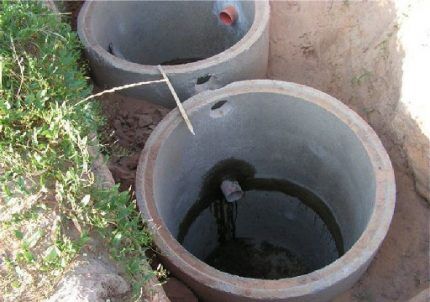
For high groundwater and loose sandy soil, we recommend installing a sealed container rather than a filter well.
He will familiarize himself with the repair of a sewer well by installing a plastic insert. next article, the contents of which we advise you to familiarize yourself with.
Conclusions and useful video on the topic
Using the videos, you will learn how to eliminate the consequences of subsidence or displacement of concrete rings of a sewer storage tank.
Video #1. Sealing seams with repair mixture:
Video #2. Raberit waterproofing testing:
Video #3. Fastening the links with staples:
Eliminating the causes of subsidence in a storage tank is a labor-intensive process that requires patience and professional skills. If you doubt the correct determination of the cause of the displacement or do not know how to repair the sump, contact a professional.
Would you like to talk about your own experience in repairing a drain pit with sagging rings? Do you know a proven way to restore its geometry? Please write comments in the block below, ask questions, share useful information and photos on the topic of the article.




I have a private house, or rather a dacha, adapted for permanent housing. So, I built the septic tank myself from concrete rings, it has two wells. The septic tank is over 10 years old and the rings have sagged slightly. So, next spring I’ll use the tips. I especially liked the second option, which has the bottom reinforced with a mesh of metal reinforcement.Then everything will definitely fall into place, it will be possible to immediately make a third, smaller well, only with reinforcement.
This happened at my dacha last year. One ring sank in the cesspool (my friends advised me to make a well from reinforced concrete rings, this is the most budget option for a summer house). When I found out, I saw that the neck of the structure had moved to the side.
I called the vacuum cleaners and the contents of the pit were completely pumped out. The problem was at the bottom of the well; the displacement occurred due to the fact that the soil under the base subsided. We strengthened it, repaired it, and now everything is ok. I never thought that a cesspool could be so much trouble.
I'm interested in how to generally determine whether this subsidence is temporary or permanent. Maybe the septic tank has sunk to a new level on a strong layer of soil and will not go further. Just wait and see?